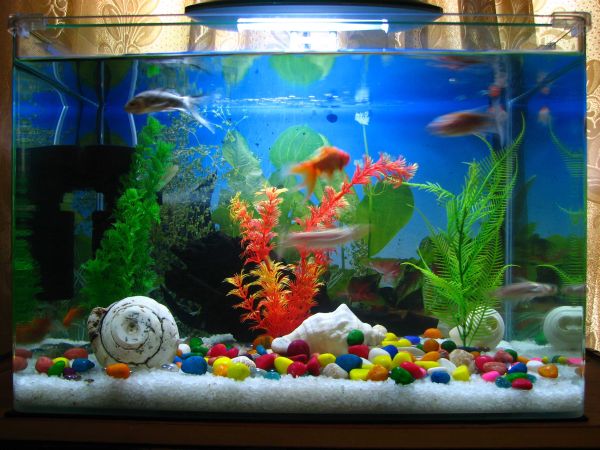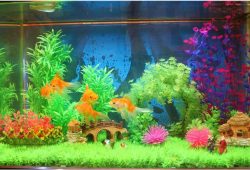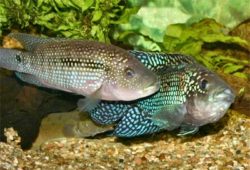Undercover survey reveals aquarium retailer filter cycling advice
The article tells you about Undercover survey reveals aquarium retailer filter cycling advice. Around 96% of aquatic retailers in the UK recommend cycling methods which could expose fish to harmful nitrogenous pollutants, an undercover survey has revealed.

Practical Fishkeeping website members acted as undercover reporters and contacted nearly 100 aquarium retailers across the country to ask them what advice they could offer on cycling a new aquarium filter.
Around 42% of stores recommended that the fishkeepers cycled their new aquarium filter with fish; a process which intentionally exposes the fish to stressful and potentially lethal levels of ammonia and nitrite, and can lead to poisoning, diseases or death.
Another 46% of stores recommended the combined approach of stocking with fish and using an off-the-shelf filter bacteria supplement claimed to boost biological filtration.
While likely to be less stressful to fish than cycling without additives, the latter process is still likely to expose fish to more pollution than the often recommend fishless cycling technique, which Practical Fishkeeping magazine and countless internet fishkeeping forums advocate. (See Frequently asked questions on fishless cycling, Matt Clarke, 11 April 2003).
Just over 4% of stores surveyed recommended the fishless cycling approach, which is widely considered to be the most ethical method for cycling an aquarium filter.
However, some of the advice offered differed dramatically to that which is typically provided through forum and magazine based information sources, suggesting few retailers fully understand the concept or recommend its use.
The stores contacted made up about 10% of the UK’s aquarium fish retailers, suggesting that the figures could be representative of the trade as a whole.
Contents
Cycling basics
Aquarium filters work biologically and depend on the growth of beneficial bacteria to break down harmful ammonia excreted by the gills of fish, and from the breakdown of their wastes.
Those bacteria remove ammonia and produce nitrite, which is also toxic to fish. Other species of bacteria take advantage of the nitrite to produce nitrate, which can be diluted by conducting regular partial water changes and topping up with dechlorinated tapwater containing a lower level of nitrate.
When the aquarium filter has established a bacterial colony large enough to remove all of the ammonia produced by fish and turn it into nitrate, the filter is called mature or cycled. The cycling or maturation process is not instant, and typically takes anything from three to six weeks depending on the temperature and chemistry of the water.
During the maturation or cycling process, the water contains high levels of ammonia and nitrite, which can endanger the lives of any fish present, often leading to disease or deaths.
There are a number of products on the market designed to act as filter boosters, which are claimed to speed up maturation, or even provide an instantly mature filter. However, some scientific research has suggested that these are not as effective as their makers claim.
The fishless cycling technique, which has been used in aquaculture for several decades, involves adding small quantities of an ammonia solution (or fish food) to an aquarium that does not yet contain fish.
The ammonia acts as an energy source for the beneficial filter bacteria, which means that fish do not, and should not, be kept in the tank during the cycling process.
The process generally takes around 4-6 weeks to complete, after which point the tank can be gradually stocked with fish.
Cycling with fish alone
Around 42% of shops surveyed recommended that fishkeepers cycle their tanks by adding so-called hardy fish. Kelly Howes told Practical Fishkeeping that several stores in Cambridgeshire had recommended that she adopt this technique.
Kelly wrote: “He told me to put everything in the tank – the gravel, décor, filter and heater – and then fill it and add dechlorinator. Then I was told to wait for four weeks and add one or two fish, then wait a few weeks before adding some more. After six weeks, I should take in some of my water so they can check it to see if it’s OK to add more fish.”
Catherine Simpson received similar advice from shops she surveyed in the Lancashire area: “I was told to make sure the water was heated up and dechlorinated had been added, then I could go to the store for a few fish. X-ray tetras were the best, she said. I was told to take some water in three weeks later so it could be tested, and I could then add fish very slowly over a period of time.”
Another store in Lancashire also told Catherine Simpson to cycle with fish alone: “I wasn’t very happy with the information I was given. I wasn’t even told to let the water heat up. I was merely told to put the water in and dechlorinate it and then go to them two or three days later for some fish.”
Andrew Yates, who contacted stores in the Durham area, said: “I was told to leave my tank running for seven days and then add three small fish. Neons were recommended, as I had mentioned that I liked them. The staff did not mention test kits or an additive, but did say that some people ‘used additives containing friendly bacteria’.”
Helen from Cambridgeshire was told: “To mature the tank, let it run for a week at 26 degrees Celsius. Then add a small number of fish. Any small shoaling tropical fish will do, but Neon tetras are good for starters, as it is easy to spot if anything goes wrong. Leave a week between each addition of fish. Do 20% water changes, but don’t change the water in the first two or three weeks and keep the gravel clean.”
Cycling with fish and additives
The most widely offered advice on cycling was to use a combination of fish and additives, with the advice given by 46% of surveyed stores.
The safety of this method depends on the performance of the product recommended. While anecdotal evidence suggests that some products can work, there is some scepticism over the effectiveness of some of the products on the market, and some research papers have provided evidence to show that some products are based on the wrong types of bacteria.
While the use of some products may speed up the cycling process and might lead to lower levels of ammonia and nitrite during maturation, it still exposes fish to ammonia and nitrite and isn’t considered as safe to fish as the fishless cycling method.
Some stores seemed to be unaware that adding water conditioners to an aquarium and leaving it for a long period would not actually help to establish adequate biological filtration. Helen from Cambridgeshire reported: “I was told to add water conditioner to the tank, turn the filter on and leave it for five to seven weeks, and then it would be mature. I should then start by adding a few fish, such as three or four Guppies or Neon tetras, leave it a week, and then add a few more. I was told that I might lose a few fish.”
Gareth Bull provided several reports for Wales. Gareth wrote: “I was told to introduce fish slowly and use additives if I wished. I was recommended to use Waterlife Bacterlife over Nutrafin Cycle, as it would allow a quick catch-up. Once the tank has been running for seven days, add maybe a couple of fish, but don’t add too many otherwise the system will crash and you’ll be back to square one.”
Cycling with additives alone
A smaller number of shops recommended the use of additives alone, with products recommended ranging from Seachem Stability, to Tetra SafeStart, API Stress Zyme and Nutrafin Cycle.
Many stores were confident that additives alone would allow new tanks to cycle sufficiently to support livestock.
Marco Babbo, who contacted stores on the Isle of Man, reported: “I was told to use Tetra SafeStart and I could then add fish after 72 hours.” Another store on the Isle of Man also recommended the same method.
Tri-Mar in Cornwall gave the same advice to a number of readers. The advice given to Mark Ormerod was typical of that which we received from several readers:
“After checking the tank dimensions and filtration they advised me to use Seachem Stability by following the instructions on the bottle. I was told to add a capful for seven days for every 80 litres of water, and then start to introduce my fish, along with additions of Stability during water changes.
“The shop also explained the importance of water changes – little and often – and suggested I stock gradually to allow the tank to mature, leaving a month after the initial stocking. They also emphasised the importance of water testing and provided fact sheets.”
Mature filter media
Just one retailer contacted recommended that new fishkeepers seed their new aquarium filter with mature filter media or substrate from the store’s aquariums.
The retailer offered to supply a small quantity of substrate from an established tank which could be used to ‘seed’ the reader’s aquarium, helping it to cycle a lot more quickly.
Fishless cycling
Just 4% of stores surveyed recommended the textbook fishless cycling technique, in which the aquarium is matured using an ammonia source, or a branded ammonia-containing filter starting supplement such as Waterlife Biomature.
Notcutt’s Pet Centre in Peterborough told Kelly Howes to use this technique when she sought advice over the telephone.
Said Kelly: “This shop gave by far the best advice. It was a pleasure to speak to Matthew (I actually asked for his name because he was so nice) and it more than made up for some of the miserable people I had previously spoken to at other shops.
“He began by telling me that that patience was the key to it all – he went on for a little while telling me about how a lot of fish die because people are in too much of a rush to get them in the tank and they don’t cycle their filters first.
“He explained about the importance of dechlorination and then explained in detail how to do a fishless cycle. He did say I could add a bacterial supplement, which would help, but it would still take a good few weeks until it was ready.
“What else can I say but fantastic! It was such a relief to speak to someone working in a fish shop who not only knew about fishless cycling, but also how to do it and explain it to someone new to the hobby.
“He also kept telling me how great fishkeeping was and how rewarding it was to look after fish and learn about them. If I was giving marks out of ten I’d give this shop a twelve!”
Pets at Home
Readers provided reports from multiple stores in two chains, the pet retailer Pets at Home and the specialist aquatic retailer Maidenhead Aquatics.
Neither chain gave consistent advice on cycling, with roughly equal numbers of stores recommending that readers cycle their new aquarium with fish alone, exposing fish to pollution, or by adding fish and a bacterial supplement together, minimising exposure a little.
Steve Fairburn, Chairman of the Pets at Home group, told Practical Fishkeeping that its customers were typically new to fishkeeping and understood little about the nitrogen cycle and the maturation of filters.
Fairburn said that Pets at Home had two “rules” when aquarium fish were sold: “Firstly we recommend that the tank is set up and running for seven days prior to adding any fish, and secondly that the number of fish added to new, or even established aquariums, be restricted. Furthermore we would recommend that new tanks initially be stocked with hardy, tolerant species.”
Fairburn added that the Pets at Home “seven day rule” had “little to do with cycling.” Rather it was there to discourage fishkeepers purchasing their aquarium and fish on the same day, and it allowed them to ensure the equipment was functioning and the tank at a stable temperature before stocking.
“Pets at Home has stocked filter boosting products for many years and recommends their use,” added Fairburn. “Where possible they are included in aquarium kits. These can be used before fish are added or at the same time that the aquarium is stocked.”
“Each Pets at Home store is staffed by welfare conscious people with varying degrees of expertise in the various types of animals we stock. However all staff are required to complete basic training within their probationary period prior to them selling any pets.
“This includes a significant amount of material on fish, the nitrogen cycle and new tank syndrome. We encourage ongoing development through further structured in house and external training. Pets at Home uses Pet Care Trust as well as OATA training courses extensively and works closely with both organisations.”
Maidenhead Aquatics
Reports of advice offered at branches of Maidenhead Aquatics, the UK’s largest specialist aquatic retailer, were split equally between cycling with fish alone, using “hardy fish” to get the filter going, and cycling with a combination of fish and a bacterial culture.
Maidenhead Aquatics’ Livestock Coordinator, Paul Tapley, told Practical Fishkeeping that the company was constantly reviewing its policies and has been testing a number of techniques, including the sale of mature filter media, which have already been adopted by some stores and are due to be launched shortly by others.
“Both Tetra and Soll, who supply the effective inocculants now stocked at most of our stores, recommend adding fish to function as an ammonia source, a fact reflected by the advice from three of the six stores mentioned. Our own trials of these products have shown them to be effective and the Bactinettes were used recently in the cycling of our Lincoln store.
“Many new fishkeepers would be loath to spend weeks with an empty tank whilst adding ammonia…many customers would simply go elsewhere and purchase fish from less scrupulous retailers – something that is all too common when new customers are told to wait a week before adding any stock, let alone four to six weeks of having an empty tank.
“It is a worthy endeavour to spread the gospel of fishless maturation and one that we intend to encourage but I think you will agree that unlike the good citizens of the forum who are established fishkeepers, potential hobbyists need something more ‘user friendly’ to avoid being discouraged from the outset.”
Tapley said that the Maidenhead Aquatics 2008 Watergarden and Aquarium brochure did encourage the use of the fishless cycling technique, and that the stance was embraced by all senior management at the group.
Citizen journalism
The survey was undertaken anonymously as part of an experiment in citizen journalism, in which Practical Fishkeeping website members acted as undercover reporters.
Matt Clarke, Practical Fishkeeping’s website editor, who devised the project said: “I’d like to thank everyone who has taken part in this undercover survey. The efforts readers have gone to, and the care they’ve put into their reporting, has really impressed me. Several of them could cut it as journalists themselves!
“A number of readers provided a large quantity of reports from entire counties and must have spent a long time on the ‘phone quizzing dealers and feigning ignorance of the subject matter.
“The results the survey has revealed really aren’t particularly encouraging. I was very surprised to see that so many retailers advise customers to add fish to new tanks during the cycling period when they are perfectly aware that conditions for the fish could become stressful.
“My hat goes off to the very few retailers who do recommend the fishless cycling method, particularly to Notcutt’s Pet Centre in Peterborough, which gave a near textbook answer to our reader reporter.”
A number of other citizen journalism projects are planned for later in 2008. For more information on these, please see the Practical Fishkeeping forum.



